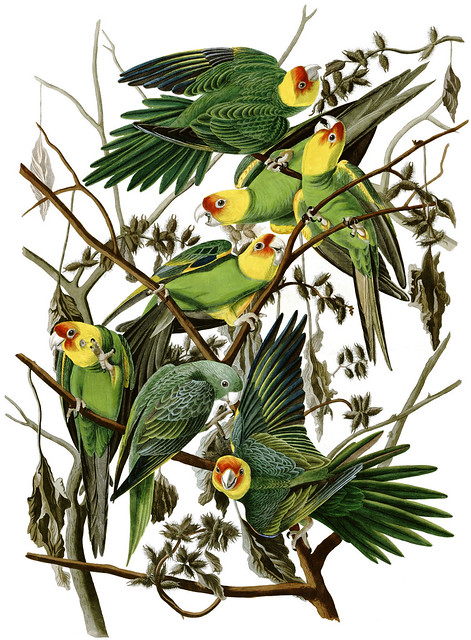Welcome to DU!
The truly grassroots left-of-center political community where regular people, not algorithms, drive the discussions and set the standards.
Join the community:
Create a free account
Support DU (and get rid of ads!):
Become a Star Member
Latest Breaking News
General Discussion
The DU Lounge
All Forums
Issue Forums
Culture Forums
Alliance Forums
Region Forums
Support Forums
Help & Search
Science
Related: About this forumExtinct Carolina parakeet gives glimpse into evolution of American parrots
http://www.guardian.co.uk/science/grrlscientist/2012/sep/19/1
Carolina parakeet, Conuropsis carolinensis, hand-colored engraving (1825).
John James Audubon (author & artist, 1785-1851). This image is in the Public Domain.
The Carolina parakeet, Conuropsis carolinensis (pictured above), was the only endemic parrot in the United States. It had one of the most northerly ranges of any parrot species, even occurring along the southern shores of Lake Ontario (see range map, right; doi:10.2173/bna.667). But European settlers quickly persecuted this colourful and widespread parrot out of existence for food, feathers, "sport" and to protect their crops. By the early 1920s, this common parrot was gone for ever.
So efficient was the extermination campaign that the Carolina parakeet disappeared before we knew much about its ecology and behaviours. The little that we do know about these iconic birds' life history and historical distribution comes from modern scientists, ornithologists and historians stitching together brief snippets penned by 19th century naturalists with personal observations reported by the few still-living people who knew this bird.
Also mysterious are the precise evolutionary relationships between the Carolina parakeet and other neotropical parrot species. Although this parrot is the only member of its genus, Conuropsis, its long, pointed tail and wings, feathered cheeks and lores, the combination of yellow and orange head plumage and blue feathers in its wings, and its comparatively broad and heavy bill closely resemble these same features in several parrots in the genus Aratinga, leading most authorities to argue they are close relatives.
But other authorities have pointed out that the Carolina parakeet's fully feathered ceres, that fleshy area surrounding its nostrils, is a trait shared with the monk parakeet, Myiopsitta monachus (doi:10.2173/bna.667), a parrot that still lives in temperate South America. For this reason, it has been proposed that the Carolina and monk parakeets may be sister species – each other's closest relatives.
InfoView thread info, including edit history
TrashPut this thread in your Trash Can (My DU » Trash Can)
BookmarkAdd this thread to your Bookmarks (My DU » Bookmarks)
3 replies, 1475 views
ShareGet links to this post and/or share on social media
AlertAlert this post for a rule violation
PowersThere are no powers you can use on this post
EditCannot edit other people's posts
ReplyReply to this post
EditCannot edit other people's posts
Rec (6)
ReplyReply to this post
3 replies
 = new reply since forum marked as read
Highlight:
NoneDon't highlight anything
5 newestHighlight 5 most recent replies
= new reply since forum marked as read
Highlight:
NoneDon't highlight anything
5 newestHighlight 5 most recent replies
Extinct Carolina parakeet gives glimpse into evolution of American parrots (Original Post)
xchrom
Sep 2012
OP
kickysnana
(3,908 posts)1. My ggrandmother had some of these at her farm in Lebanon TN ca 1912
They were semi tame. Lived in a a stand of trees and would mimic what sounded like "companies coming" when anyone approached the farm, according to my grandfather.
mopinko
(70,077 posts)2. and those relatives are repopulating the us.
iirc, the cherry headed conures that are spreading from san francisco are of the aratinga genus. they are having their troubles, but are increasing, i believe.
the monks are now everywhere in chicago. several other spots across the country have colonies.
Odin2005
(53,521 posts)3. I find it astonishing that they lived as far north as Chicago.
Every time I read about those birds I become infuriated at how we hunted them into extinction. ![]()